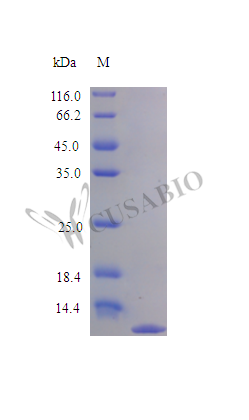The generation of recombinant rat CCL17 protein starts with the cloning of the gene fragment encoding the 24-93aa of rat CCL17 into a vector that would be inserted into the E.coli, followed by upstream bioprocessing, and finally the downstream process for purification. Its purity reaches over 97% as determined by SDS-PAGE. It contains endotoxin below 1.0 EU/μg as measured by the LAL method. This recombinant rat CCL17 protein has been verified to be active, with the biological activity of a concentration range of 1.0-10 ng/ml using human T-lymphocytes by a chemotaxis bioassay.
The rat CCL17 protein is primarily involved in the recruitment and activation of Th2 cells, which are pivotal in mediating allergic responses and various inflammatory conditions. This chemokine is constitutively expressed in the thymus and can be induced in various cell types, including peripheral blood mononuclear cells, macrophages, and bronchial epithelial cells [1]. In rat models, CCL17 has been implicated in several pathophysiological conditions, including asthma, pulmonary fibrosis, and responses to environmental pollutants such as cigarette smoke [1][2][3].
The interaction of CCL17 with its receptor, CCR4, is significant in mediating Th2 cell responses. Studies have shown that the expression of CCL17 is upregulated in the lungs of rats subjected to various inflammatory stimuli, which correlates with increased numbers of CCR4-positive lymphocytes, suggesting a role in Th2-dominant immune responses [2][3]. Furthermore, the neutralization of CCL17 has been shown to reduce airway hyperresponsiveness in animal models, indicating its importance in asthma pathogenesis [4][5].
Research has also indicated that CCL17 is involved in the pathophysiology of idiopathic pulmonary fibrosis (IPF). Elevated levels of CCL17 and CCR4 have been observed in models of bleomycin-induced pulmonary fibrosis, highlighting its role in the recruitment of inflammatory cells to the lung tissue [3].
References:
[1] S. Suzuki, K. Asai, M. Gi, K. Kojima, A. Kakehashi, Y. Oishiet al., Response biomarkers of inhalation exposure to cigarette smoke in the mouse lung, Journal of Toxicologic Pathology, vol. 35, no. 3, p. 247-254, 2022. https://doi.org/10.1293/tox.2021-0077
[2] T. Inoue, S. Fujishima, E. Ikeda, O. Yoshie, N. Tsukamoto, S. Aisoet al., Ccl22 and ccl17 in rat radiation pneumonitis and in human idiopathic pulmonary fibrosis, European Respiratory Journal, vol. 24, no. 1, p. 49-56, 2004. https://doi.org/10.1183/09031936.04.00110203
[3] Y. Yogo, S. Fujishima, T. Inoue, F. Saito, T. Shiomi, K. Yamaguchiet al., Macrophage derived chemokine (ccl22), thymus and activation-regulated chemokine (ccl17), and ccr4 in idiopathic pulmonary fibrosis, Respiratory Research, vol. 10, no. 1, 2009. https://doi.org/10.1186/1465-9921-10-80
[4] S. Santulli-Marotto, K. Boakye, E. Lacy, S. Wu, J. Luongo, K. Kavalkovichet al., Engagement of two distinct binding domains on ccl17 is required for signaling through ccr4 and establishment of localized inflammatory conditions in the lung, Plos One, vol. 8, no. 12, p. e81465, 2013. https://doi.org/10.1371/journal.pone.0081465
[5] S. Santulli-Marotto, J. Fisher, T. Petley, K. Boakye, T. Panavas, J. Luongoet al., Surrogate antibodies that specifically bind and neutralize ccl17 but not ccl22, Monoclonal Antibodies in Immunodiagnosis and Immunotherapy, vol. 32, no. 3, p. 162-171, 2013. https://doi.org/10.1089/mab.2012.0112




